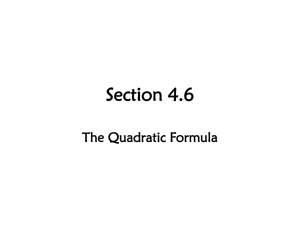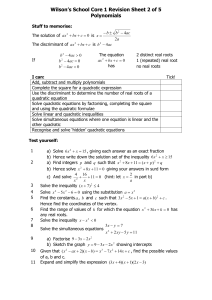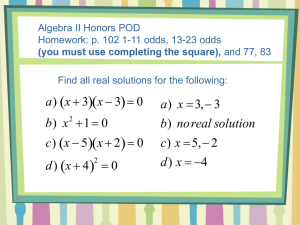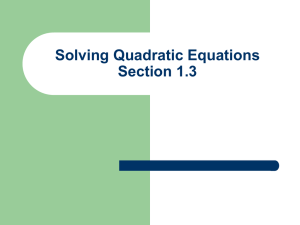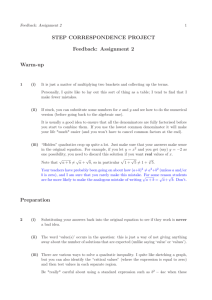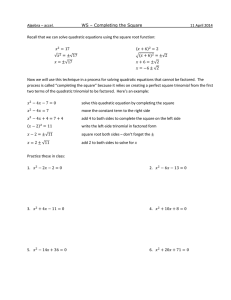Quadratic Equations Section P.8
advertisement
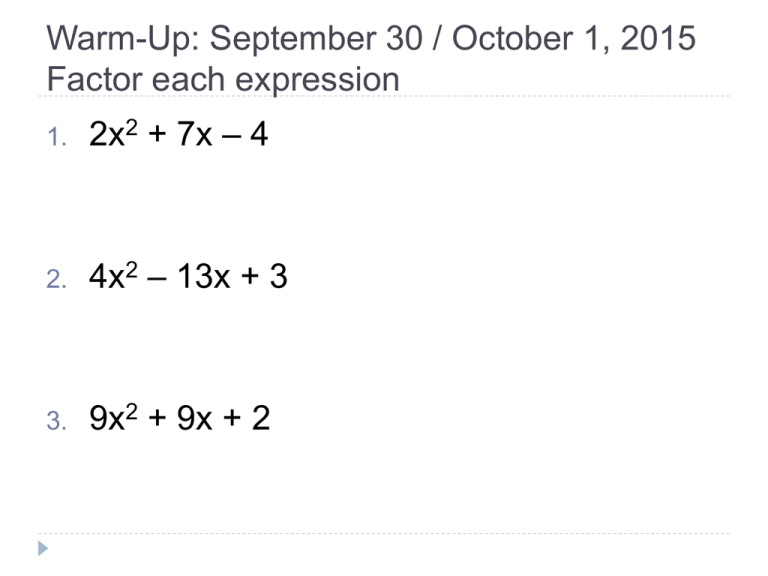
Warm-Up: September 30 / October 1, 2015 Factor each expression 1. 2x2 + 7x – 4 2. 4x2 – 13x + 3 3. 9x2 + 9x + 2 Homework Questions? Quadratic Equations Section P.8 Essential Question How can we solve quadratic equations? Quadratic Equations A quadratic is a second-degree polynomial The general form is 2 ax bx c 0 a, b, c R , a 0 Zero Product Property If AB = 0, then A = 0 or B = 0 Use to solve a quadratic 1. Write the quadratic in general form 2. Factor the quadratic 3. Set each factor equal to zero 4. Solve each equation You-Try #1: Solve by Factoring a) 3x 9 x 0 2 b) 2 x x 1 2 Solving Quadratics Using Square Roots Use when you have x2 + c = 0 (b=0) Also used when you have an expression squared and a number (u2=d) 1. Get the squared term by itself 2. Take the square root of both sides 3. Remember ± You-Try #2: Solve with Square Root a) 4 x 24 2 b) x 5 2 13 Completing the Square Given 𝑥 2 + 𝑏𝑥, we can create a perfect square trinomial by dividing b by 2, squaring it, and adding it 2 b b x bx x 2 2 2 2 When solving, you must have one side be “𝑥 2 + 𝑏𝑥” Remember that whatever you add to one side, you must add to the other side Example 3: Completing the Square (#27-37) Determine the constant that should be added to the binomial so that it becomes a perfect square trinomial. Then write and factor the trinomial x 14 x 2 You-Try #3: Completing the Square (#27-37) Determine the constant that should be added to the binomial so that it becomes a perfect square trinomial. Then write and factor the trinomial 4 x x 5 2 Example 4a: Solving by Completing the Square 2 x 5x 3 0 2 You-Try #4: Solving by Completing the Square 2x 4x 1 0 2 Example 4b: Solving by Completing the Square 2 ax bx c 0 The Quadratic Formula b b 4ac x 2a 2 You-Try #5: Solving using Quadratic Formula 3x 6 x 1 2 The Discriminant: b2 – 4ac The value of the discriminant tells you the number and type of solutions you will have Discriminant b2 – 4ac < 0 b2 – 4ac = 0 b2 – 4ac > 0 Is a perfect square b2 – 4ac > 0 Not a perfect square Solutions to ax2 + bx + c = 0 The Discriminant: b2 – 4ac The value of the discriminant tells you the number and type of solutions you will have Discriminant Solutions to ax2 + bx + c = 0 b2 – 4ac < 0 No real solutions b2 – 4ac = 0 One real solution b2 – 4ac > 0 Is a perfect square Two rational solutions b2 – 4ac > 0 Not a perfect square Two irrational solutions b x 2a Example 6: Using the Discriminant (#63-69) Compute the discriminant. What does the discriminant indicate about the number and type of solutions? 3x 2 x 1 2 You-Try #6: Using the Discriminant (#63-69) Compute the discriminant. What does the discriminant indicate about the number and type of solutions? 2 x 11x 6 0 2 What method should I use? 1. 2. 3. 4. If 𝑎𝑥 2 + 𝑏𝑥 + 𝑐 can easily be factored, then factor and use zero product property. If 𝑏 = 0, use square root method If you have something in parentheses squared, use square root method. If 𝑎𝑥 2 + 𝑏𝑥 + 𝑐 cannot be factored, use quadratic formula See page 94 if you need more help choosing what method to use. Assignment Read Section P.8 Page 97 #1-93 Every Other Odd, 99, 119
